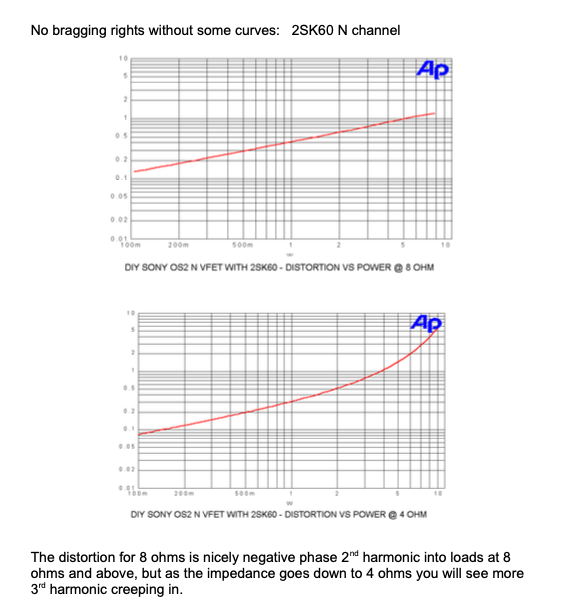It is interesting that Nelson has come up with something like this; however, I doubts that this goes to the heart of addressing the difference between SET designs and Push/pull designs. It makes two assumptions: 1) That the injection of 2nd order harmonic all by itself is the answer to systems with "warmth" issues and 2) It assumes that his device makes only 2nd order harmonic and not other, higher order harmonics.
Let's look first at assumption 1. IMO, this idea of just adding some second order harmonic is a gross oversimplification to a very complex perceptual experience. If you inject just a bit, it will be inaudible due to masking and if you add a lot it will warm up or golden up or something the sound but it won't make it necessarily sound like a good SET OR like real life. Real life instruments and sounds are (mostly) mechanical in nature and as such make monotonic distortion patterns (except for chaotic instruments like cymbals). SETs also make a similar pattern (more or less following the pattern depending on the quality of the design). The point is that it is not just one harmonic that shapes perception but the pattern of the harmonics as a function of SPL. Injecting a lot of 2nd order will not just give you the right pattern and will have a different impact depending on the level you listen as this new harmonic injection is overlaid with whatever your source, preamp and amp make at a given output level.
Assumption 2 does not hold as the data Mr. Pass shows clearly has 2nd, 3rd, 4th and likely beyond (not shown); however, the pattern is monotonic, which suggests it might mimic an ideal distortion pattern that our ear brain finds essentially invisible at lower distortion levels. If this pattern is higher level than the one it is overlaid onto but still low overall would this then trick the ear/brain into being less audible or are the effects additive and it will be like trying to smear lipstick on a pig??
OR is this kind of like what a designer might attempt to do with a hybrid design, where the input/driver stages are triode tube and have a roughly monotonic pattern (in Class A without feedback at least) and then use a high bias AB or A MOSFET stage to be as transparent as possible (According to Boyk and Sussmann's simulations a Class A PP MOSFET stage would have essentially no harmonic distortion...of course that is with a perfect transistor and perfect power supply...both of which do not exist). I have heard some pretty successful (and not so successful) designs of this type. The more successful were significantly more musical and less artificial sounding than comparable all transistor types. Perhaps Pass's device is close enough to a triode mimic that it can achieve something similar?
I throw this open to debate... curious for your opinions.
Let's look first at assumption 1. IMO, this idea of just adding some second order harmonic is a gross oversimplification to a very complex perceptual experience. If you inject just a bit, it will be inaudible due to masking and if you add a lot it will warm up or golden up or something the sound but it won't make it necessarily sound like a good SET OR like real life. Real life instruments and sounds are (mostly) mechanical in nature and as such make monotonic distortion patterns (except for chaotic instruments like cymbals). SETs also make a similar pattern (more or less following the pattern depending on the quality of the design). The point is that it is not just one harmonic that shapes perception but the pattern of the harmonics as a function of SPL. Injecting a lot of 2nd order will not just give you the right pattern and will have a different impact depending on the level you listen as this new harmonic injection is overlaid with whatever your source, preamp and amp make at a given output level.
Assumption 2 does not hold as the data Mr. Pass shows clearly has 2nd, 3rd, 4th and likely beyond (not shown); however, the pattern is monotonic, which suggests it might mimic an ideal distortion pattern that our ear brain finds essentially invisible at lower distortion levels. If this pattern is higher level than the one it is overlaid onto but still low overall would this then trick the ear/brain into being less audible or are the effects additive and it will be like trying to smear lipstick on a pig??
OR is this kind of like what a designer might attempt to do with a hybrid design, where the input/driver stages are triode tube and have a roughly monotonic pattern (in Class A without feedback at least) and then use a high bias AB or A MOSFET stage to be as transparent as possible (According to Boyk and Sussmann's simulations a Class A PP MOSFET stage would have essentially no harmonic distortion...of course that is with a perfect transistor and perfect power supply...both of which do not exist). I have heard some pretty successful (and not so successful) designs of this type. The more successful were significantly more musical and less artificial sounding than comparable all transistor types. Perhaps Pass's device is close enough to a triode mimic that it can achieve something similar?
I throw this open to debate... curious for your opinions.








